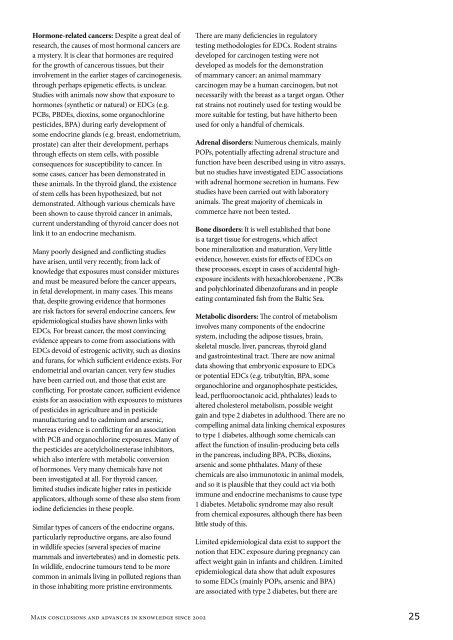Endocrine Disrupting Chemicals 2012 - World Health Organization
Endocrine Disrupting Chemicals 2012 - World Health Organization
Endocrine Disrupting Chemicals 2012 - World Health Organization
Create successful ePaper yourself
Turn your PDF publications into a flip-book with our unique Google optimized e-Paper software.
Hormone-related cancers: Despite a great deal of<br />
research, the causes of most hormonal cancers are<br />
a mystery. It is clear that hormones are required<br />
for the growth of cancerous tissues, but their<br />
involvement in the earlier stages of carcinogenesis,<br />
through perhaps epigenetic effects, is unclear.<br />
Studies with animals now show that exposure to<br />
hormones (synthetic or natural) or EDCs (e.g.<br />
PCBs, PBDEs, dioxins, some organochlorine<br />
pesticides, BPA) during early development of<br />
some endocrine glands (e.g. breast, endometrium,<br />
prostate) can alter their development, perhaps<br />
through effects on stem cells, with possible<br />
consequences for susceptibility to cancer. In<br />
some cases, cancer has been demonstrated in<br />
these animals. In the thyroid gland, the existence<br />
of stem cells has been hypothesized, but not<br />
demonstrated. Although various chemicals have<br />
been shown to cause thyroid cancer in animals,<br />
current understanding of thyroid cancer does not<br />
link it to an endocrine mechanism.<br />
Many poorly designed and conflicting studies<br />
have arisen, until very recently, from lack of<br />
knowledge that exposures must consider mixtures<br />
and must be measured before the cancer appears,<br />
in fetal development, in many cases. This means<br />
that, despite growing evidence that hormones<br />
are risk factors for several endocrine cancers, few<br />
epidemiological studies have shown links with<br />
EDCs. For breast cancer, the most convincing<br />
evidence appears to come from associations with<br />
EDCs devoid of estrogenic activity, such as dioxins<br />
and furans, for which sufficient evidence exists. For<br />
endometrial and ovarian cancer, very few studies<br />
have been carried out, and those that exist are<br />
conflicting. For prostate cancer, sufficient evidence<br />
exists for an association with exposures to mixtures<br />
of pesticides in agriculture and in pesticide<br />
manufacturing and to cadmium and arsenic,<br />
whereas evidence is conflicting for an association<br />
with PCB and organochlorine exposures. Many of<br />
the pesticides are acetylcholinesterase inhibitors,<br />
which also interfere with metabolic conversion<br />
of hormones. Very many chemicals have not<br />
been investigated at all. For thyroid cancer,<br />
limited studies indicate higher rates in pesticide<br />
applicators, although some of these also stem from<br />
iodine deficiencies in these people.<br />
Similar types of cancers of the endocrine organs,<br />
particularly reproductive organs, are also found<br />
in wildlife species (several species of marine<br />
mammals and invertebrates) and in domestic pets.<br />
In wildlife, endocrine tumours tend to be more<br />
common in animals living in polluted regions than<br />
in those inhabiting more pristine environments.<br />
There are many deficiencies in regulatory<br />
testing methodologies for EDCs. Rodent strains<br />
developed for carcinogen testing were not<br />
developed as models for the demonstration<br />
of mammary cancer; an animal mammary<br />
carcinogen may be a human carcinogen, but not<br />
necessarily with the breast as a target organ. Other<br />
rat strains not routinely used for testing would be<br />
more suitable for testing, but have hitherto been<br />
used for only a handful of chemicals.<br />
Adrenal disorders: Numerous chemicals, mainly<br />
POPs, potentially affecting adrenal structure and<br />
function have been described using in vitro assays,<br />
but no studies have investigated EDC associations<br />
with adrenal hormone secretion in humans. Few<br />
studies have been carried out with laboratory<br />
animals. The great majority of chemicals in<br />
commerce have not been tested.<br />
Bone disorders: It is well established that bone<br />
is a target tissue for estrogens, which affect<br />
bone mineralization and maturation. Very little<br />
evidence, however, exists for effects of EDCs on<br />
these processes, except in cases of accidental highexposure<br />
incidents with hexachlorobenzene , PCBs<br />
and polychlorinated dibenzofurans and in people<br />
eating contaminated fish from the Baltic Sea.<br />
Metabolic disorders: The control of metabolism<br />
involves many components of the endocrine<br />
system, including the adipose tissues, brain,<br />
skeletal muscle, liver, pancreas, thyroid gland<br />
and gastrointestinal tract. There are now animal<br />
data showing that embryonic exposure to EDCs<br />
or potential EDCs (e.g. tributyltin, BPA, some<br />
organochlorine and organophosphate pesticides,<br />
lead, perfluorooctanoic acid, phthalates) leads to<br />
altered cholesterol metabolism, possible weight<br />
gain and type 2 diabetes in adulthood. There are no<br />
compelling animal data linking chemical exposures<br />
to type 1 diabetes, although some chemicals can<br />
affect the function of insulin-producing beta cells<br />
in the pancreas, including BPA, PCBs, dioxins,<br />
arsenic and some phthalates. Many of these<br />
chemicals are also immunotoxic in animal models,<br />
and so it is plausible that they could act via both<br />
immune and endocrine mechanisms to cause type<br />
1 diabetes. Metabolic syndrome may also result<br />
from chemical exposures, although there has been<br />
little study of this.<br />
Limited epidemiological data exist to support the<br />
notion that EDC exposure during pregnancy can<br />
affect weight gain in infants and children. Limited<br />
epidemiological data show that adult exposures<br />
to some EDCs (mainly POPs, arsenic and BPA)<br />
are associated with type 2 diabetes, but there are<br />
Main conclusions and advances in knowledge since 2002<br />
25
















